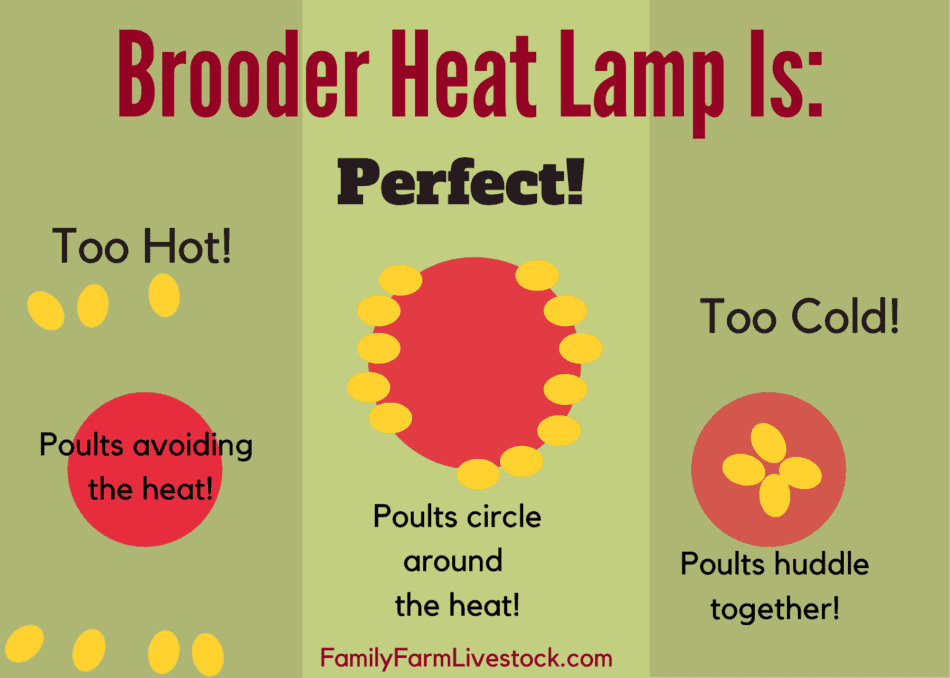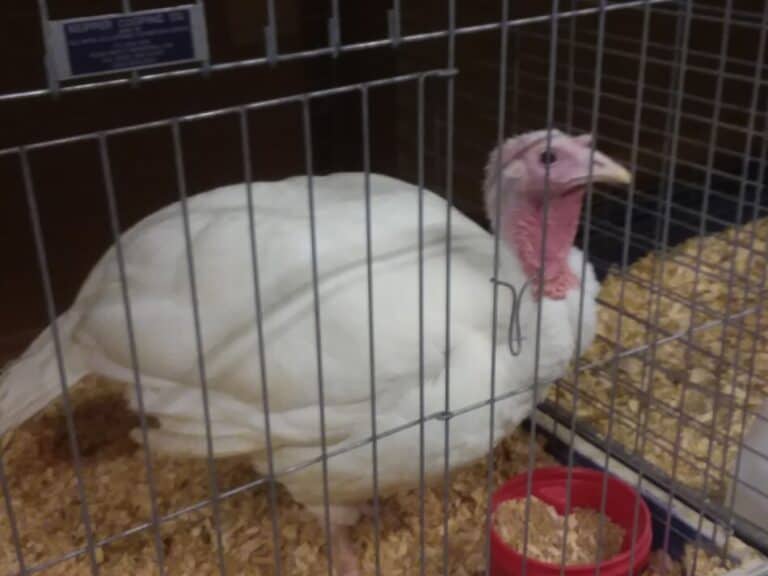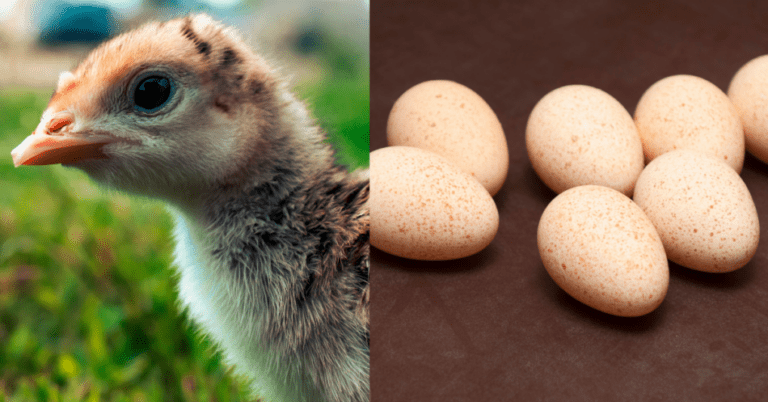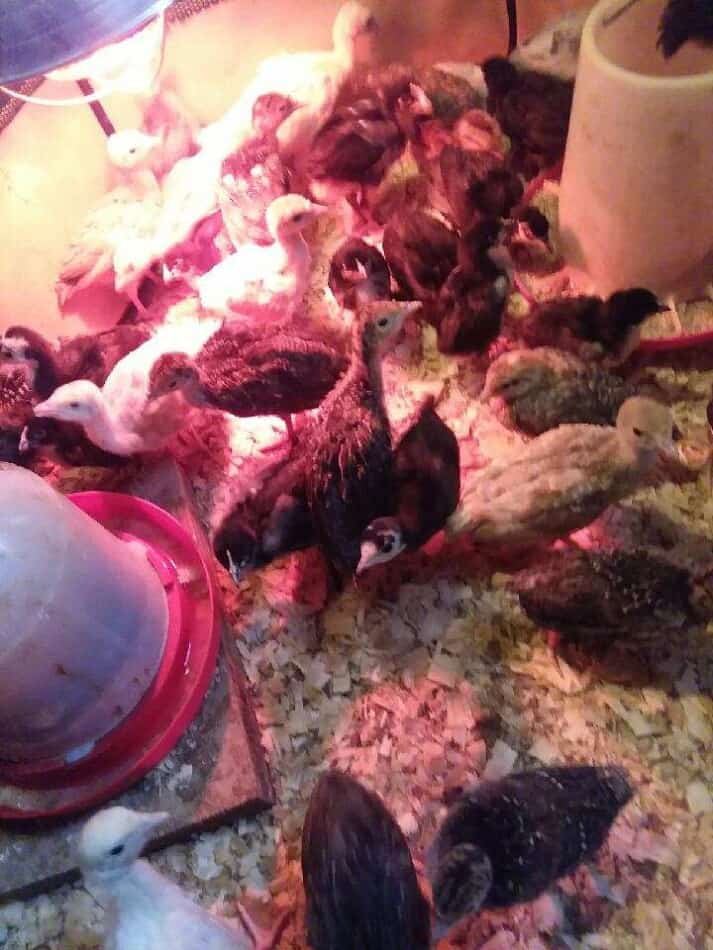Space To Raise Turkeys, Brooder And Grow Out Areas

How much space do you need to raise turkey poults?
Turkey poults need 2.5 sq. ft. each in the brooder and 10 sq. ft. each in the grow out pen. Turkeys on grass need a 25×25 sq. ft. area each.
| Age of turkey | Pen area per poult |
| 0-3 weeks (in a brooder) | 1 sq. ft. |
| 3-6 weeks (in a brooder) | 2.5 sq. ft. |
| 6-8 weeks (brood until fully feathered) | 2.5 sq. ft |
| 8-16 weeks | 4 sq, ft. |
| 16-20 weeks | 8 sq. ft |
| 20+ weeks | 10 sq. ft |
| 8+ weeks (pasture/yard) | 25×25 ft. area |
Home grown turkey, yum! Your own birds toast those turkeys you can get in the store, by a mile!
Welcome to a whole new world of fun and, of course, taste! You’ll never go back, trust me. Let’s get started!
How Much Feed Do Turkeys Need? will help you figure up your feed costs. Is Raising Turkeys For Meat Worth It? has all costs involved in raising your own meat turkeys.

Day old turkeys need 1 sq. ft. each in a brooder
When you get your turkey poults they will need to go into a brooder that has 1 sq. ft. per poult.
A brooder is a secure, warm area where they will live until they are grown enough to not need the supplemental heat.
All young birds need a brooder, but it does not have to be fancy, it just needs to be warm and secure.
Section off a part of your garage or a predator proof building to brood your poults in.
The secure part is important here, all predators including your cats and rats, love to eat baby poultry.
You’ll notice that the space requirements change a bit for the poults as they grow. The day old poults will be fine with 1 sq. ft. per bird.
Be sure to have non heated areas of the brooder, a great place to put the feed and water, so the poults have a choice of where to hang out.
From 3-6 weeks, poults need 2.5 sq. ft. each
As they grow, but still need the supplemental heat, increase their brooder area to 2.5 sq. ft. per poult.
Keep the spacing at 2.5 sq. ft. each for as long as the poults are in the brooder.
Your poults will need to stay in a brooder until they are fully feathered, which will take anywhere from 6-8 weeks.
Don’t rush this part. Turkeys do not recover well from set backs, and taking away their heat before they are ready can cause problems.
Reduce brooder temp every week to transition poults
You should be decreasing the brooder temperature every week to get them used to going without, but you should not take it away all at once.
At 8 weeks, poults need 4 sq. ft. each
Once your poults reach 8 weeks, they will need more space, 4 sq. ft. each.
This would also be a great time to introduce them to the outdoors, if you are going to pasture them.
Poults on grass need a small starter pen and a shelter
If you decide to put your poults on grass, make sure they can still get into a shelter, so they have cover when bad weather pops up.
Introduce your turkeys to a smaller outdoor area for the first few days, then enlarge the roaming area.
Keeping the pasture or yard area small initially, helps the poults find their way back into the shelter and prevents one from getting separated from the others.
When Can Turkey Poults Go Outside? gives you more details on setting up an outside pen that is safe for your poults.

Have a turkey proof fence (holes they can’t fit through)
Be sure to use a turkey proof fence that is 4 feet tall. These little characters can jump and fly a little bit, enough to get over a short fence.
The second reason for a tight fence is to keep out the predators that are hoping to snack on your poults.
Predators love to eat turkeys, they are just too easy to catch. Stay vigilant on this one.
If you are in a heavy predation area, keep the turkeys in an enclosure unless you are home and keep them in at night.
As long as the weather is decent, your turkeys don’t need to be inside. These measures are strictly to keep your birds out of easy reach of the predators.
At 16 weeks, poults need 8 sq. ft. each
At 16 weeks your turkeys are really going to be growing! From now until 20 weeks they need 8 sq. ft. each of pen space.
If you are keeping your birds outside on pasture or your yard, you’ll need to give them a 25×25 foot area per bird. This works out to be 625 sq. ft. each.
A 25×25 foot area per turkey means you can have 16 turkeys on a quarter acre (10,890 sq. ft.) or 8 turkeys on an eighth acre (5,445 sq. ft.).
Turkeys need 25×25 ft. each on grass
A smaller area than 25×25 will have the turkeys ruining the grass in that area as they get bigger.
If you have limited space, make a pen that you rotate around your yard or section off the yard in to 2 or 3 areas and rotate the turkeys through each area.
By changing the grass the turkeys have access to, you are keeping a fresh lunch in front of them and evening out their bug eating and fertilizing.
By 20 weeks, your turkeys need 10 sq. ft. each
Once your turkeys reach 20 weeks, they will be hitting their finishing weight soon, some of the broad breasted white toms may already be huge!
You’ll want to increase their pen space to at least 10 sq. ft. per bird at this stage. If your turkeys are on grass, you’ve already got this covered!
Weigh some of those toms, if you haven’t butchered them yet. You may be surprised at how big they are already!
If you have a heritage breed of turkey, you are probably not at a finishing weight yet with your birds, but weigh a few anyway to be sure.
If you have them on pasture, keep the 25×25 area. If you have extra yard, move the turkeys to a new spot, they’ll love it!
Resources:
ALBC Turkey How To Raise Turkeys On Pasture, Chapter 3: Pasturing Turkeys
Michigan State University Extension, Grow Your Own Thanksgiving Turkey
Small Flock Turkey Production, Penn State Extension




